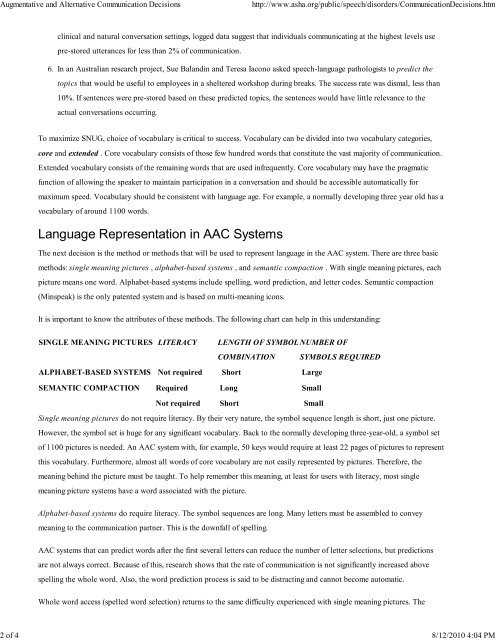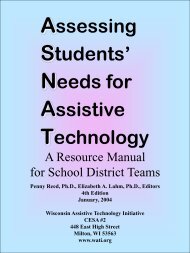Augmentative and Alternative Communication Decisions
Augmentative and Alternative Communication Decisions
Augmentative and Alternative Communication Decisions
You also want an ePaper? Increase the reach of your titles
YUMPU automatically turns print PDFs into web optimized ePapers that Google loves.
<strong>Augmentative</strong> <strong>and</strong> <strong>Alternative</strong> <strong>Communication</strong> <strong>Decisions</strong> http://www.asha.org/public/speech/disorders/<strong>Communication</strong><strong>Decisions</strong>.htm<br />
clinical <strong>and</strong> natural conversation settings, logged data suggest that individuals communicating at the highest levels use<br />
pre-stored utterances for less than 2% of communication.<br />
6. In an Australian research project, Sue Bal<strong>and</strong>in <strong>and</strong> Teresa Iacono asked speech-language pathologists to predict the<br />
topics that would be useful to employees in a sheltered workshop during breaks. The success rate was dismal, less than<br />
10%. If sentences were pre-stored based on these predicted topics, the sentences would have little relevance to the<br />
actual conversations occurring.<br />
To maximize SNUG, choice of vocabulary is critical to success. Vocabulary can be divided into two vocabulary categories,<br />
core <strong>and</strong> extended . Core vocabulary consists of those few hundred words that constitute the vast majority of communication.<br />
Extended vocabulary consists of the remaining words that are used infrequently. Core vocabulary may have the pragmatic<br />
function of allowing the speaker to maintain participation in a conversation <strong>and</strong> should be accessible automatically for<br />
maximum speed. Vocabulary should be consistent with language age. For example, a normally developing three year old has a<br />
vocabulary of around 1100 words.<br />
Language Representation in AAC Systems<br />
The next decision is the method or methods that will be used to represent language in the AAC system. There are three basic<br />
methods: single meaning pictures , alphabet-based systems , <strong>and</strong> semantic compaction . With single meaning pictures, each<br />
picture means one word. Alphabet-based systems include spelling, word prediction, <strong>and</strong> letter codes. Semantic compaction<br />
(Minspeak) is the only patented system <strong>and</strong> is based on multi-meaning icons.<br />
It is important to know the attributes of these methods. The following chart can help in this underst<strong>and</strong>ing:<br />
SINGLE MEANING PICTURES LITERACY LENGTH OF SYMBOL NUMBER OF<br />
COMBINATION<br />
ALPHABET-BASED SYSTEMS Not required Short Large<br />
SEMANTIC COMPACTION Required Long Small<br />
Not required Short Small<br />
SYMBOLS REQUIRED<br />
Single meaning pictures do not require literacy. By their very nature, the symbol sequence length is short, just one picture.<br />
However, the symbol set is huge for any significant vocabulary. Back to the normally developing three-year-old, a symbol set<br />
of 1100 pictures is needed. An AAC system with, for example, 50 keys would require at least 22 pages of pictures to represent<br />
this vocabulary. Furthermore, almost all words of core vocabulary are not easily represented by pictures. Therefore, the<br />
meaning behind the picture must be taught. To help remember this meaning, at least for users with literacy, most single<br />
meaning picture systems have a word associated with the picture.<br />
Alphabet-based systems do require literacy. The symbol sequences are long. Many letters must be assembled to convey<br />
meaning to the communication partner. This is the downfall of spelling.<br />
AAC systems that can predict words after the first several letters can reduce the number of letter selections, but predictions<br />
are not always correct. Because of this, research shows that the rate of communication is not significantly increased above<br />
spelling the whole word. Also, the word prediction process is said to be distracting <strong>and</strong> cannot become automatic.<br />
Whole word access (spelled word selection) returns to the same difficulty experienced with single meaning pictures. The<br />
2 of 4 8/12/2010 4:04 PM











